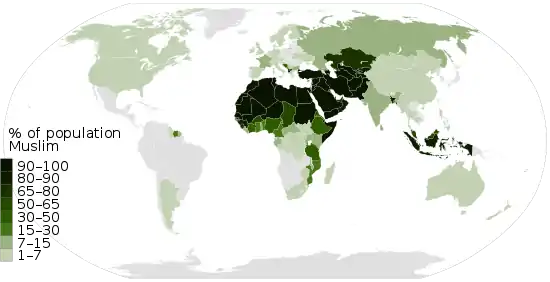Islam in Eswatini
The nation of Eswatini is home to over a million people, of which approximately 2% identify as Muslim, most of whom belong to Sunni branch. Islam in Eswatini probably dates to the colonial period, when, as in Eswatini's much larger neighbor South Africa, many Muslims settled in the country from other countries under the dominion of the British Empire.
| Islam by country |
|---|
 |
|
|
History
While Muslims settled in Eswanti during the colonial period, an active community emerged around the early 1960s when Malawian Muslims arrived in Eswanti to work in asbestos mines. A few locals converted and Malawi-Swazi communities formed in some small towns. Islam became a recognized religion in 1972 by the approval of Sobhuza II. Muslims since then have partaken in the national Good Friday festivities to pray for the well-being of the monarch and many Islamic institutions have been established in urban areas.[1]
Population
According to the CIA World Factbook, only 2% of Eswatini's Christian-majority population are Muslim.[2] The Muslim community in Eswatini comprises local Muslim (most of whom identify as Sunni Muslims) and refugees and immigrants from Asia and neighbouring African states.[3] The Ahmadiyya Muslim Community claims 250 members in the country.[4]
Law and politics
Muslim marriages in Eswatini are not included in the Marriage Act of 1964 which governs civil marriages. However, according to local imam Luqman Asooka, Muslim marriages are considered as custom marriages that are allowed in the constitution which guarantees "freedom of worship".[3]
See also
References
- Tayob, Abdulkader (1999). "Southern Africa". In Westerlund, David; Svanberg, Ingvar (eds.). Islam Outside the Arab World. London: Routledge. p. 115. ISBN 0-7007-1124-4.
- "Eswatini". CIA World Factbook. Retrieved 6 May 2020.
- Zulu, Phathizwe (26 November 2016). "Swaziland marriage law leaves Muslims in legal quagmire". Anadolu Agency.
- Ahmadiyya Muslim Mosques Around the World. The Ahmadiyya Muslim Community. 2008. pg. 107. ISBN 1-882494-51-2